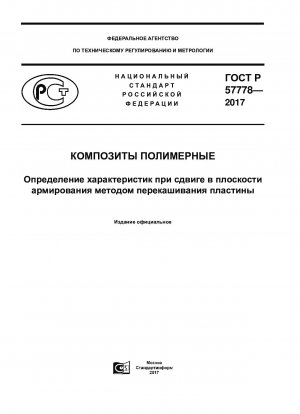ASTM D4255/D4255M-15a
Standard Test Method for In-Plane Shear Properties of Polymer Matrix Composite Materials by the Rail Shear Method
- Standard No.
- ASTM D4255/D4255M-15a
- Release Date
- 2015
- Published By
- American Society for Testing and Materials (ASTM)
- Status
- Replace By
- ASTM D4255/D4255M-20
- Latest
- ASTM D4255/D4255M-20e1
- Scope
5.1 These shear tests are designed to produce in-plane shear property data for material specifications, research and development, and design. Factors that influence the shear response and should therefore be reported include: material, methods of material preparation and lay-up, specimen stacking sequence, specimen preparation, specimen conditioning, environment of testing, specimen alignment and gripping, speed of testing, time at temperature, void content, and fiber volume reinforcement content. Properties that may be measured by this test method include:
5.1.1 In-plane shear stress versus engineering shear strain response,
5.1.2 In-plane shear chord modulus of elasticity,
5.1.3 Offset shear stress, and
5.1.4 Maximum in-plane shear stress. In cases in which the engineering shear strain at failure is greater than 58201;%, the shear stress corresponding to 58201;% engineering shear strain should be reported.
1.1 This test method determines the in-plane shear properties of high-modulus fiber-reinforced composite materials by either of two procedures. In Procedure A, laminates clamped between two pairs of loading rails are tested. When loaded in tension the rails introduce shear forces in the specimen. In Procedure B, laminates clamped on opposite edges with a tensile or compressive force applied to a third pair of rails in the center are tested.
1.2 Application of this test method is limited to continuous-fiber or discontinuous-fiber-reinforced polymer matrix composites in the following material forms:
1.2.1 Laminates composed only of unidirectional fibrous laminae, with the fiber direction oriented either parallel or perpendicular to the fixture rails.
1.2.2 Laminates composed only of woven fabric filamentary laminae with the warp direction oriented either parallel or perpendicular to the fixture rails.
1.2.3 Laminates of balanced and symmetric construction, with the 0° direction oriented either parallel or perpendicular to the fixture rails.
1.2.4 Short-fiber-reinforced composites with a majority of the fibers being randomly distributed.
Note 1: Additional test methods for determining in-plane shear properties of polymer matrix composites may be found in Test Methods D3518/D3518M, D5379/D5379M, D5448/D5448M, and D7078/D7078M.
1.3 The reproducibility of this test method can be affected by the presence of shear stress gradients in the gage section and stress concentrations at the gripping areas. Test Methods
ASTM D4255/D4255M-15a history
- 2020 ASTM D4255/D4255M-20e1 Standard Test Method for In-Plane Shear Properties of Polymer Matrix Composite Materials by the Rail Shear Method
- 2020 ASTM D4255/D4255M-20 Standard Test Method for In-Plane Shear Properties of Polymer Matrix Composite Materials by the Rail Shear Method
- 2015 ASTM D4255/D4255M-15a Standard Test Method for In-Plane Shear Properties of Polymer Matrix Composite Materials by the Rail Shear Method
- 2015 ASTM D4255/D4255M-15 Standard Test Method for In-Plane Shear Properties of Polymer Matrix Composite Materials by the Rail Shear Method
- 2001 ASTM D4255/D4255M-01(2007) Standard Test Method for In-Plane Shear Properties of Polymer Matrix Composite Materials by the Rail Shear Method
- 2001 ASTM D4255/D4255M-01 Standard Test Method for In-Plane Shear Properties of Polymer Matrix Composite Materials by the Rail Shear Method
- 1983 ASTM D4255/D4255M-83(1994)e1 Standard Test Method for In-Plane Shear Properties of Polymer Matrix Composite Materials by the Rail Shear Method

Copyright ©2024 All Rights Reserved